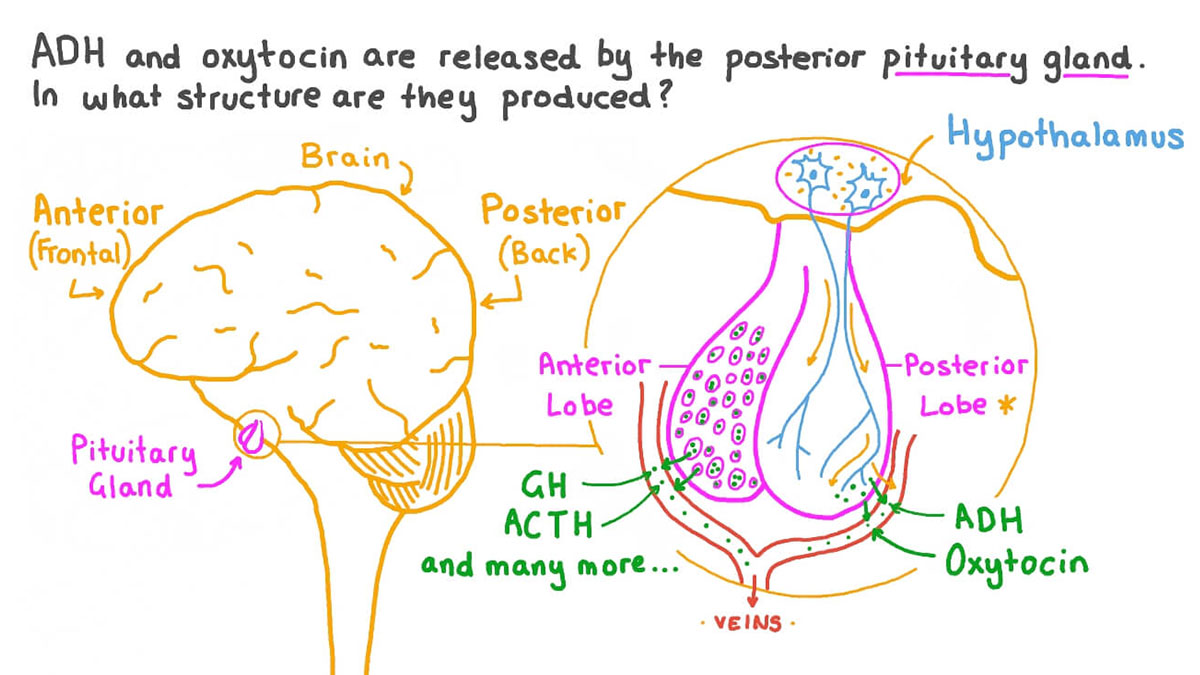
Antidiuretic hormone (ADH), also known as vasopressin, plays a crucial role in regulating the body’s water balance and maintaining blood pressure. Understanding where ADH is produced and how it functions can provide valuable insights into how our bodies manage fluid balance and respond to various physiological needs. This article delves into the production, function, and regulation of ADH, and its significance for overall health.
1. What is Antidiuretic Hormone (ADH)?
**1.1. Definition and Function
- Antidiuretic Hormone (ADH): ADH is a peptide hormone that helps regulate water retention in the body by influencing kidney function.
- Primary Functions:
- Water Retention: ADH signals the kidneys to reabsorb water back into the bloodstream, reducing urine output and helping to concentrate the urine.
- Blood Pressure Regulation: By influencing blood volume, ADH also plays a role in maintaining blood pressure.
**1.2. Chemical Nature
- Type of Hormone: ADH is a peptide hormone composed of nine amino acids. It is produced in the hypothalamus and released by the posterior pituitary gland.
2. Where is ADH Produced?
**2.1. The Hypothalamus
- Location: The hypothalamus is a region located at the base of the brain, just above the brainstem.
- Function in ADH Production: Specialized neurons in the hypothalamus, known as neurosecretory cells, synthesize ADH. These cells are responsible for producing and storing ADH until it is needed.
**2.2. The Posterior Pituitary Gland
- Location: The posterior pituitary gland is located at the base of the brain, below the hypothalamus, and is connected to it by a stalk called the infundibulum.
- Function in ADH Release: Once synthesized in the hypothalamus, ADH is transported to the posterior pituitary gland, where it is stored and eventually released into the bloodstream in response to physiological signals.
3. Regulation of ADH Release
**3.1. Stimuli for ADH Release
- Increased Blood Osmolality: When the concentration of solutes in the blood rises, such as during dehydration, ADH is released to promote water reabsorption and dilute the blood.
- Decreased Blood Volume: A drop in blood volume or blood pressure can trigger ADH release to help restore blood volume by retaining water.
**3.2. Feedback Mechanisms
- Osmoreceptors: Located in the hypothalamus, these receptors detect changes in blood osmolality and influence ADH release.
- Baroreceptors: These sensors, found in blood vessels, monitor blood pressure and help regulate ADH secretion in response to blood pressure changes.
**3.3. Inhibition of ADH Release
- Excessive Fluid Intake: Drinking large amounts of water can dilute blood osmolality, leading to reduced ADH release and increased urine output.
- Alcohol: Alcohol can inhibit ADH release, contributing to increased urine production and dehydration.
4. Disorders Related to ADH
**4.1. Diabetes Insipidus
- Definition: A condition characterized by inadequate ADH production or poor response to ADH, leading to excessive thirst and large volumes of diluted urine.
- Types:
- Central Diabetes Insipidus: Results from insufficient ADH production due to damage to the hypothalamus or pituitary gland.
- Nephrogenic Diabetes Insipidus: Occurs when the kidneys are unable to respond properly to ADH.
**4.2. Syndrome of Inappropriate Antidiuretic Hormone (SIADH)
- Definition: A condition in which excess ADH is produced, leading to water retention, low blood sodium levels (hyponatremia), and fluid imbalance.
- Causes: Can be caused by various factors, including certain medications, lung diseases, or tumors.
5. Maintaining Healthy ADH Function
**5.1. Hydration
- Balanced Fluid Intake: Maintain adequate hydration by drinking water throughout the day and adjusting fluid intake based on physical activity and environmental conditions.
**5.2. Monitoring Health Conditions
- Regular Check-Ups: Regular medical check-ups can help identify and manage conditions that affect ADH production or regulation.
- Medication Management: If diagnosed with a condition affecting ADH, follow medical advice and treatment plans to manage symptoms and maintain balance.
Conclusion
Antidiuretic hormone (ADH) is a vital hormone produced in the hypothalamus and released by the posterior pituitary gland. It plays a key role in regulating water balance, blood pressure, and overall fluid homeostasis. Understanding where ADH is produced and how its release is regulated helps in recognizing its importance in maintaining health and managing conditions related to fluid balance. If you experience symptoms of ADH-related disorders, consult with a healthcare professional for accurate diagnosis and appropriate treatment.
